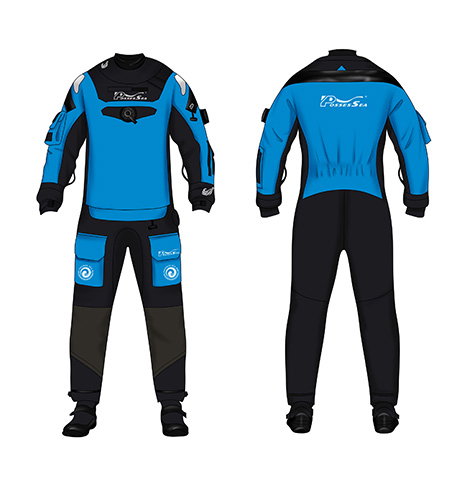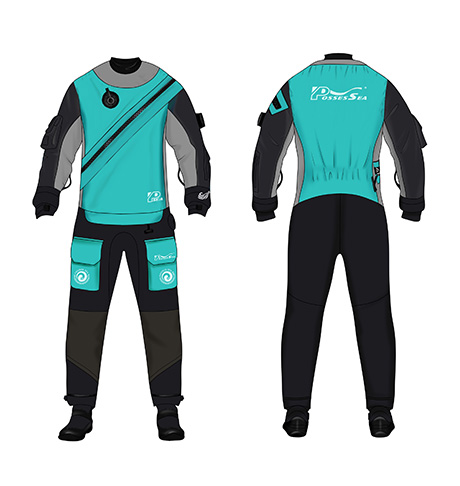Possess Sea Industrial Co., Ltd. - Drysuits Division
Professional Drysuit & Waders Manufacturer, Supplier and Exporter in China
Professional Drysuit & Waders Manufacturer, Supplier and Exporter in China
Contact: Ms.Maggie, Mobile / WhatsApp: +86 138 168 15888, E-mail: maggie@wetsuit.asia
Amphibious Drysuit - Manufacturer and Supplier
The amphibious drysuits originated from the assault drysuit of the navy / air force special forces, that is, they need to keep the combatants dry before arriving at the combat site (transport aircraft, helicopters and submarine transportation). After arriving at the combat site, there is no need to change suits and can directly conduct penetration operations in the underwater environment. Based on this demand, a military assault drysuit made of breathable tri-laminate fabric was developed that can be used in amphibious environment.
In recent years, with the demand for lightweight drysuits for recreational diving, many brands have launched casual drysuits based on navy assault drysuits. We also follow the trend and produce such products, but it must be pointed out that , This product is not exactly the same as diving drysuit. It is a kind of drysuits that takes into account both water and underwater performance. For diving applications, it is only suitable for a depth of no more than 20 meters (depending on different materials, usually 10 meters depth), so it is not a professional diving drysuit.
Amphibious drysuit due to the limitation of its own material (the middle layer membrane), PU film is prone to yellowing and cracking, PTFE film is easy to layer, and is not resistant to folding, so its durability is not as good as that of butyl tri-laminate drysuit. In addition, its diving depth is far less than the needs of scuba diving. Amphibious drysuit is a product with specific usage scenarios, which is suitable for some specific needs. If you use it as a substitute for butyl tri-laminate drysuit of diving, it will be a wrong choice and you will encounter some unforeseen troubles.
Breathable Tri-Laminate Amphibious Drysuit - DA21
Material: Breathable tri-laminate fabric, outer layer: 330D Cordura®, middle layer: PU + PTFE, inner layer: 20D Tricot.
Process: "Stitch", single-thread or double-thread buried clip car to ensure the firmness of the seam. "Hot Tape", the seam use hot melt tape to ensure water resistance.
Neck / Wrists: SI-TECH® Modular Seal System (Optional latex or silicone seal).
Back Zip: Two YKK® PROSEAL® (BDM - PU40 & 50) / YKK® AQUASEAL® drysuit zippers are used on the back and crotch, use a zipper on the crotch, no need to take off the clothes go to the toilet.
Inflation / Exhaust Valve: SI-TECH®.
Pee Valve: SI-TECH® / Halcyon.
Shoulders / Elbows / Knees: Cordura® / KEVLAR®.
Feet: Latex socks / Cordura® socks.
Breathable Tri-Laminate Amphibious Drysuit - DA22
Material: Breathable tri-laminate fabric, outer layer: 320D Nylon 66, middle layer: PTFE, inner layer: 20D Tricot.
Process: "Stitch", single-thread or double-thread buried clip car to ensure the firmness of the seam. "Hot Tape", the seam use hot melt tape to ensure water resistance.
Neck / Wrists: Latex seals (UK).
Front Zip: Two YKK® AQUASEAL® / TIZIP™ SuperSeal drysuit zippers are used on the back and crotch, use a zipper on the crotch, no need to take off the clothes go to the toilet.
Inflation / Exhaust Valve: SI-TECH®.
Shoulders / Elbows / Knees: Cordura® / KEVLAR®.
Feet: Latex socks / Cordura® socks.
Breathable Tri-Laminate Fabric Type:
| Outer Layer | 210D Nylon | 320D Nylon | 330D Cordura® |
| Middle Layer | PU | PTFE | PU + PTFE |
| Inner Layer | 20D Tricot | ||
SGS Test Report (Breathable Tri-Laminate Fabric):
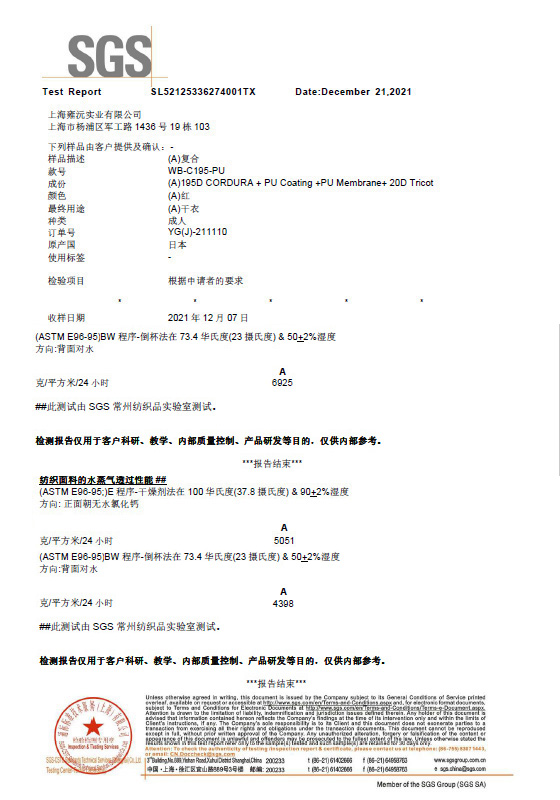
WB-C195-PU & PU SGS Test
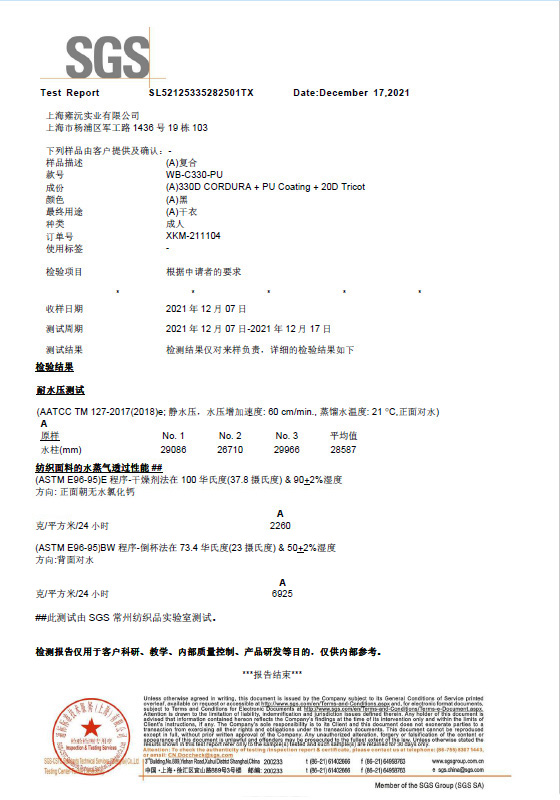
WB-C330-PU SGS Test
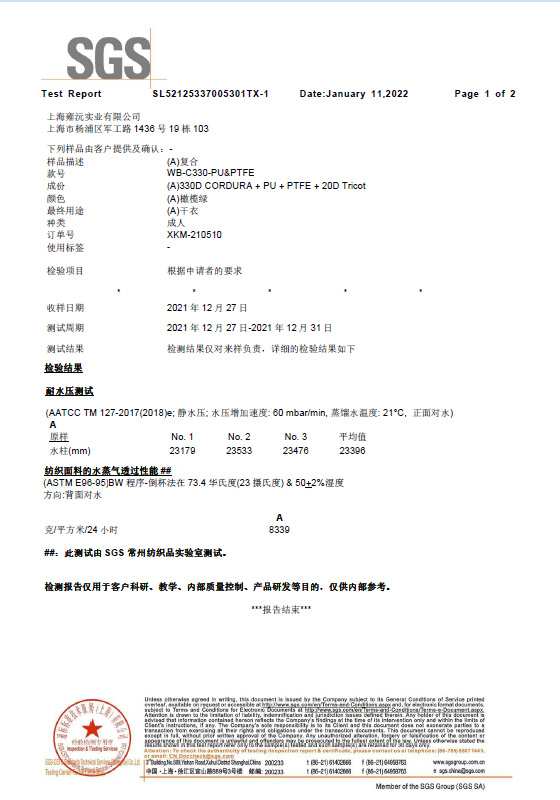
WB-C330-PU & PTFE SGS Test
Description of SGS Test Products:
Usually, we use the American Standard ASTM E96/E96M method for moisture permeability test. This method specifies six test procedures. The test results obtained by different test procedures or even different versions of the same test procedure are very different. When comparing the performance indicators of related products, it is necessary to pay attention to the test program and version. The results of different programs and versions are not comparable.
Drysuit Type:
| Type | Neoprene Drysuit | Butyl Drysuit | Breathable Drysuit |
| Material | Neoprene Fabric | Butyl Fabric | Breathable Fabric |
| Process | Glue & Blind Stitch + Glue Tape | Flatlock Stitch + Glue Tape | Flatlock Stitch + Hot Tape |
| Firmness | Good | Good | Ordinary |
| Easy to Carry | Not Good | Ordinary | Good |
| Thermal Insulation | Good | Little | Little |
| Valve | Inflation Valve, Exhaust Valve | Inflation Valve, Exhaust Valve | No or Dump Valve |
| Applications | Diving | Diving | Water Sports, Rescue |


